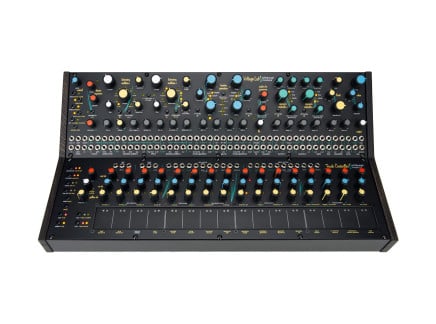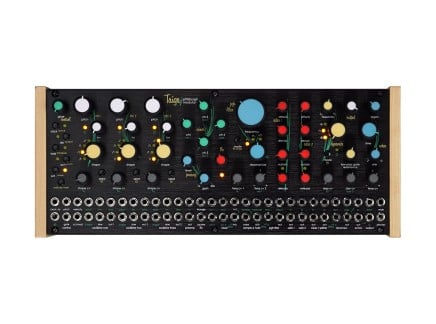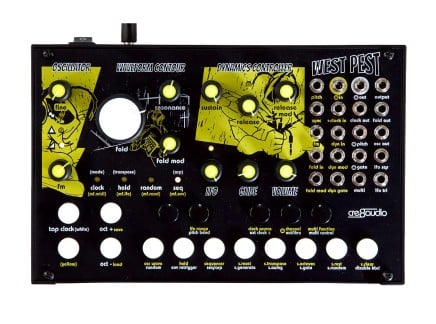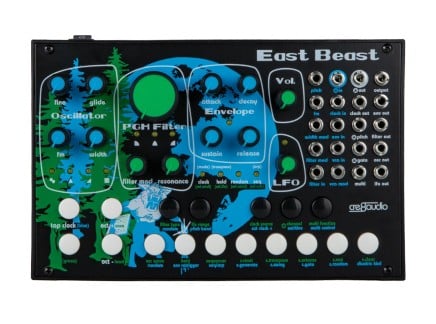Pittsburgh Modular has introduced the Voltage Lab 2—a startlingly fully-featured modular synthesizer. I dare say, though, that Voltage Lab 2 transcends the concept of a preconfigured system of discrete general-purpose modules. Its form factor and the logic of its inner workings position it not merely as a conglomeration of individual circuits, but as a fully-thought-out, well-considered instrument. Additionally, we may view the term "Instrument" here through multiple lenses. Voltage Lab 2 is certainly a musical instrument, but Pittsburgh also describes it as an instrument for research—research into the boundaries of analog sound production and manipulation.
Voltage Lab 2 is a self-contained modular synthesizer system organized as two 90HP modules in a dedicated case. The upper module—labeled simply "Voltage Lab 2"—is composed of a host of audio and control voltage generation and manipulation utilities. The bottom module, on the other hand, is the Touch Controller 2, a wild and remarkably sophisticated touch keyboard/sequencer that seems to take cues from the Serge TKB, Buchla Model 248 Multiple Arbitrary Function Generator, and other peculiar/complex tools for gestural and algorithmic control. So, when I say that Voltage Lab 2 is a "complete" instrument, what I mean is that it has its own quite deep methods of sound generation, manipulation, and control built right in.
Voltage Lab 2 is, of course, the spiritual successor to Pittsburgh's peculiar modern classic instrument, 2019's Voltage Research Laboratory (VRL). Despite its highly successful Kickstarter campaign and general public fanfare, VRL was famously discontinued quite quickly—leading both the general public and Pittsburgh Modular founder Richard Nicol to regularly lament that they "really should have made more of them." Nicol has promised a followup instrument many times since...and today Pittsburgh delivers on that promise.
However, while it would be easy to point specifically to VRL as the immediate ancestor to today's Voltage Lab 2, this would ignore several other important intermediate developments. Voltage Lab 2 also follows years of Pittsburgh's small-run, boutique experimental module development; additionally, it builds upon their manufacturing collaboration with Cre8audio, which has previously yielded the quite popular East Beast, West Pest, and Taiga.
So, to explain my thoughts briefly:
- Voltage Lab 2 develops on years of technical innovations
- Voltage Lab 2 is the latest in a long line of self-contained Pittsburgh instruments
- Voltage Lab 2 is, hands down, Pittsburgh's most complete and well-thought-out instrument to date
- The manufacturing collaboration with Cre8audio means that Voltage Lab 2—unlike its predecessor, VRL—should be available for as long as people want to buy them
With the release of Taiga in 2023, I published an article that briefly touched on the evolution of Pittsburgh's many self-contained and semi-modular instruments—you can check out that article here for a better idea of how Voltage Lab 2 fits in to Pittsburgh's history as a whole. Though it is tempting, I won't retread that ground today; instead, let's jump straight to discussing what the Voltage Lab 2 contains and how you might use it.
A Brief Orientation
Pittsburgh's Voltage Lab 2 is a modular synthesizer system designed for intuitive experimentation and exploration of complex systems. Like many modular instruments in the modern era, it borrows design inspiration from Donald Buchla's once-obscure and now-iconic 1973 instrument/art device, the Music Easel. Voltage Lab 2's form factor and high-level organizational concept do closely resemble the Easel: the upper half of the instrument is a host of sound generators and manipulators, as well as a host of control voltage generation/processing utilities; the bottom half of the instrument is a capacitive touch controller; the middle of the instrument is the place where all patching takes place. Additionally, the Voltage Lab 2 continues Pittsburgh's exploration/advancement of some classic Buchla tone-shaping concepts, such as nonlinear waveshaping and frequency-domain gating (i.e. low pass gates).
These similarities aside, though, the Voltage Lab 2 is far from a Music Easel clone. It has its own internal logic—its own language—its own rules, all of which combine to create an instrument with its own unique, distinct sonic identity. Combining novel analog synthesis concepts with the open-ended possibilities of the digitally-mediated touch interface/sequencer, the Voltage Lab 2 presents a unique opportunity for constructing all manner of sounds and interactions. I find it difficult to resist extra-musical associations and terminology in describing its sound—it can be surprisingly tactile, organic, rubbery, bouncy, squishy, screechy, and much more. At times, its sounds are simply uncanny and will stand your hair on end. Moreover, it permits any degree of complexity with regard to control and user interaction. It's quite simple to, for instance, use the keyboard to create a melody or sequence; the same set of tools, though, can instead be used to create results that constantly shift, change, and surprise you.
I should state before continuing that, despite all of the Voltage Lab 2 module's circuitry being housed behind a single panel, I would not exactly describe it as being semi-modular. A few simple/basic normalled connections aside, the Voltage Lab 2 does not featured a normalled signal path: like its predecessor VRL, it is up to the user to define the bulk of their audio and control signal paths using patch cables. As a result, some patches can require a significant number of cables—but the placement of all module I/O in the middle of the instrument keeps both the keyboard and module controls physically accessible in even the densest of patches. All that to say, VL2 does not proscribe a specific signal path as a default: it's quite open-ended, with many options for how you might want to construct your own personal workflow. We can, then, think of the individual submodules as raw ingredients, which may be arbitrarily combined however you see fit.
Pittsburgh Modular Voltage Lab 2 Overview

The leftmost portion of the VL2 module include a MIDI to CV converter (complete with arpeggiator, a la Taiga, East Beast, West Pest, etc.); one may, if desired, use external MIDI to control the internal oscillators, function generators, and dynamics controllers without the use of patch cables from the MIDI to CV converter itself. Of course, much of the fun of the instrument as a whole comes from the interaction of the Touch Controller 2 and the VL2 module—but it's good to have access to a straightforward MIDI input for scenarios that require it. Note—in addition to the convenient internal connections to the MIDI to CV converter, you also get dedicated outputs for clock, pitch, velocity, gate, and an assignable CC. Next in line is the Chance Sequencer—a sort of random voltage generator based on shift register-style sequencing concepts. Near the Chance Sequencer on the patch bay, you'll also find a noise source and sample & hold.
Then come the stars of the show: the Laboratory Oscillators. Each of these oscillators present their own unique approaches to continuously variable waveshaping, including tricks that we've seen manifest in some of Pittsburgh's recent boutique, small-batch Eurorack modules (e.g. center clipping, pulse symmetry, etc.). Each oscillator can operate from LFO to ultrasonic range, and each features a variety of interesting waveshaping potential—useful both in scenarios where the oscillators are used as sound or modulation sources.
Laboratory Oscillator 1 focuses on extending Buchla-esque analog waveshaping techniques. It offers a selection of seed shapes for the shaping section, with standard and "warped" variants of sine, triangle, saw, and square shapes represented. Using Pittsburgh's all-but-miraculous waveshaping technologies that seem to "fold the unfoldable," this oscillator will provide you everything from straightforward folded sines to downright mindboggling timbres, all with no fewer than four continuously variable, voltage-controllable timbre controls. Combining Michael Johnsen's peculiar "center clipping" concepts with controls familiar to us from more typical waveshaping implementations, you'll get access to not just a wide range of tones, but a wide range of possibilities for how sound can evolve over time. Additionally, you get an FM input, four simultaneous outputs, and even a dedicated input to the shaping circuit—great for folding any sound you desire (perhaps from within VL2, or perhaps from an external instrument?). This oscillator section strikes me as being quite similar to the three oscillators in Taiga—and happily, with a little bit of creative patching and feedback, it can get every bit as gnarly as (if not gnarlier than) its forebear.
Laboratory Oscillator 2 similarly offers a wide range of timbres, albeit through different means. Like the first oscillator, it uses selectable seed waveforms (sine, triangle, saw, pulse) and provides different methods for shaping them. The "reflection" control hinges around what one might call a sort of variable rectification, in which one half of a waveform is mirrored about a specific voltage—gradually transforming saws into triangles, doubling the frequency of sines and triangles, etc. Using the "reflection" parameter and CV input, you can achieve interesting and seemingly nonlinear changes to the sound's spectrum. When using the pulse shape as a seed, you gain access to controls for pulse width and pulse symmetry—effectively producing a sort of simple "stair step" waveform where the horizontal and vertical proportions of the steps can be continuously varied (and even modulated). In practice, the sounds from Laboratory Oscillator 2 are quite different from Laboratory Oscillator 1; generally speaking, the first oscillator produces a more extreme range of unfamiliar timbres, while the second oscillator stays somewhere closer to the types of tones one might expect from conventional analog oscillators (albeit with a number of quite fun bells and whistles for adding nuanced or extreme alterations to these familiar tones). As with the first oscillator, the second provides multiple simultaneous outputs, and offers a dedicated FM input, width CV input, reflect CV input, and a dedicated input to the reflection circuit for processing external signals.
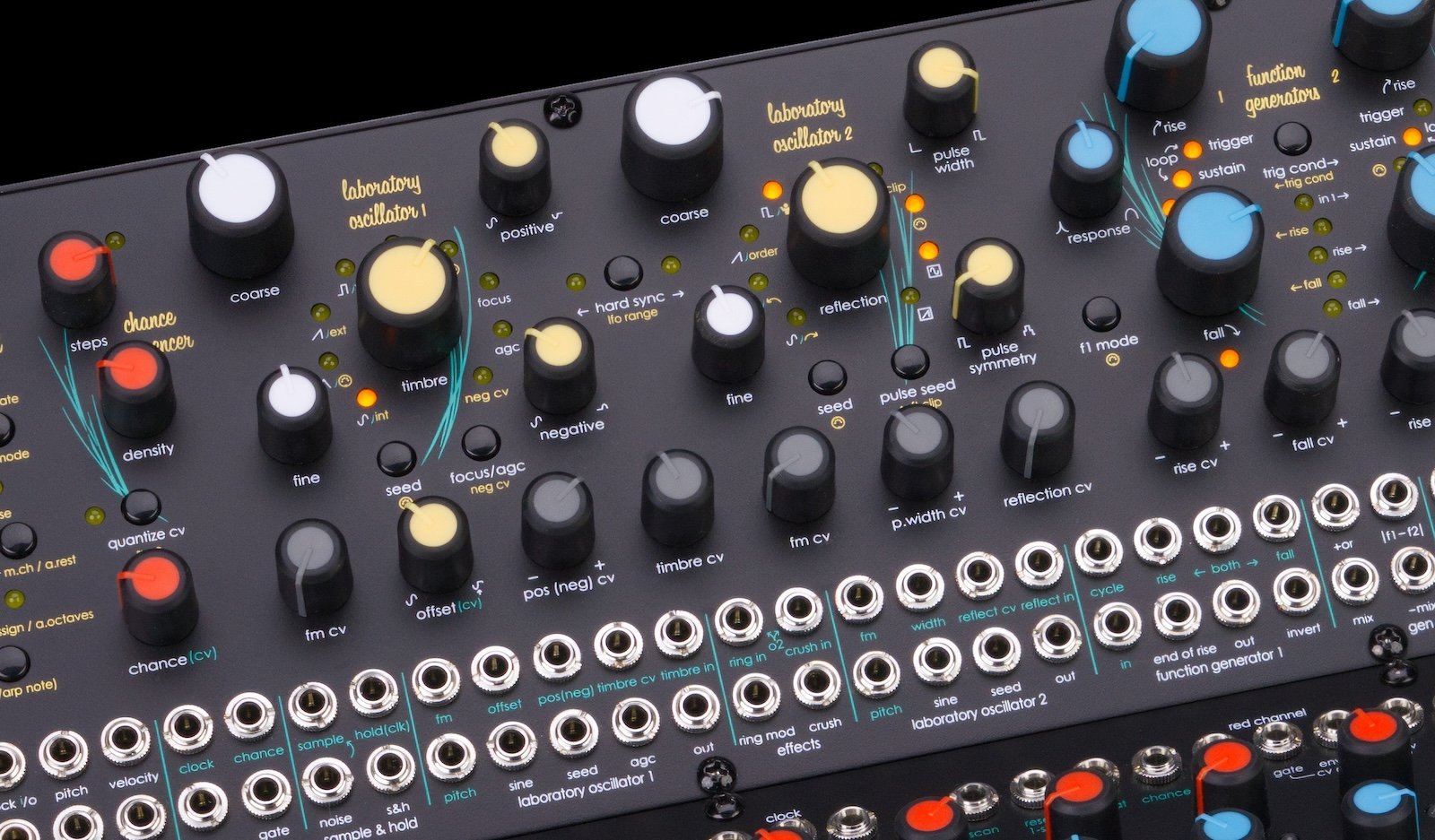
The oscillator section also offers provisions for a variety of special effects. Between the two oscillators on the patch bay, you'll find a ring modulator and "crush" (sample rate reduction) circuit, each with a dedicated output and a single dedicated input. The astute among you might note that ring modulation and sample rate reduction each require two signals—so what gives with the single input for each? Essentially, Pittsburgh has hardwired the output of the first oscillator into each of these circuits, and has normalled the second oscillator to the input jacks for each circuit. By default, the sine outputs from each oscillator are multiplied for ring modulation; you can defeat the connection of the second oscillator's sine to this circuit simply by patching whatever signal you desire into the "ring in" jack, at which point the incoming sound will be ring modulated with the first oscillator's sine output. For the crush circuit, the primary post-waveshaping output from oscillator 1 is used as the data source, with the second oscillator is used to establish a sample rate for the "crush" process. Again, any signal may be patched into the "crush in" to override the connection from the second oscillator. As for sound character, the ring modulator is lovely when used with the default sine connections, and can be quite intense with other signal sources.
Additionally, it should be noted that the ring modulator DC-coupled, allowing for use as a sort of crude VCA for the first oscillator's sine signal—for example, try plugging a function generator into the ring in to impose a dynamic envelope on the outgoing sine wave. Likewise, because the oscillators themselves have such a wide range (from LFO to ultrasonic), you can patch any audio signal into the ring in jack and turn osc. 1's frequency down in order to generate tremolo-like effects.
Likewise, there are plenty of weird tricks to be achieved with the crush circuit. For instance, despite its ostensible purpose as a sound mangling tool, we can remember that the core of analog downsampling is, essentially, a sample and hold circuit. So, without needing to patch anything, if you run oscillator 2 at a relatively low frequency, the crush output jack (which is DC-coupled) will produce a set of more-or-less random voltages derived from the interference pattern between oscillators one and two with respect to oscillator 1's waveshape. That is to say, the crush output is a sample and hold output which uses oscillator 1 as its input signal, and oscillator 2 as the "hold" signal. At high rates, this gives us destructive distortion-like effects and intense inharmonic sidebands, but at low rates, it gives us stepped control voltages. You can patch any other trigger source (from the function generators, for example) into the crush in to free up oscillator 2 for, well, more typical oscillator-like duties. [Pro tip for all of you feedback patch weirdos: try patching the ring mod and crush outputs back to the FM or CV inputs for the oscillators. You'll delight in all manner of clicks, pops, fizz, and howls—some of the finer dishes available from modular cuisine, altogether.]
Oh, by the way—the oscillators can be hard-sync'd to one another using a dedicated button. This enables you to use either oscillator as the sync source or destination...and additionally enables bi-directional sync for especially unruly effects.
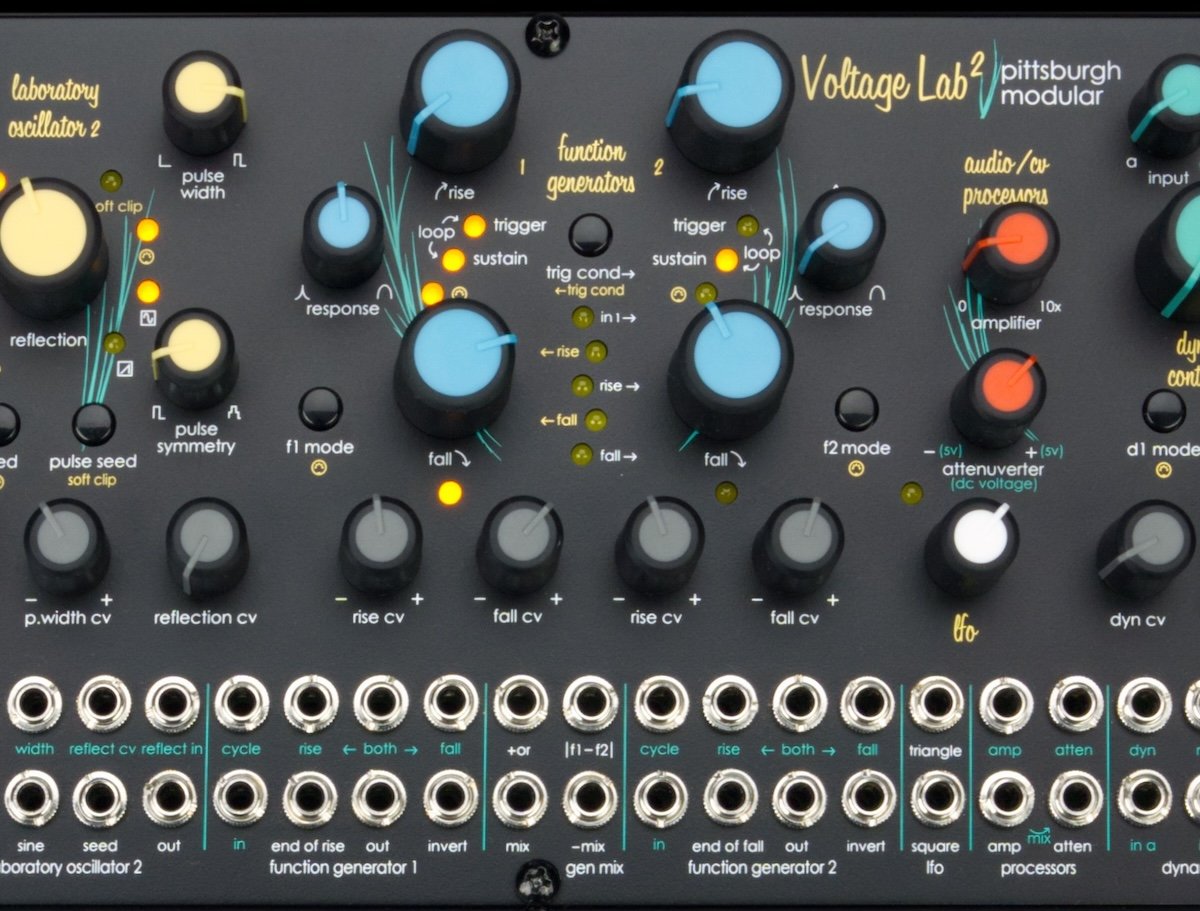
Moving on from the oscillators, we fine two function generators: slew limiters in the style of the Serge Dual Universal Slope Generator. Though it is practical to look at these as the system's envelope generators—which in all fairness, they sort of are—let's put practicality aside. While you certainly can use the function generators for the purpose of envelope generation, they can also act as simple slew limiters, as variable-shape LFOs, as timing signal generators, peculiar waveshapers, or even as audio oscillators all their own. They follow the familiar parameterization of the Serge DUSG and its many derivatives (Maths, et al), offering independent rise and fall times, continuously variable curve shape (response) from extreme logarithmic shapes all the way to extreme exponential shapes. Each function generator offers dedicated rise and fall CV inputs with dedicated attenuverters, as well as a "both" CV input and a cycle input. Each can operate in "trigger," "sustain," and "loop" modes; in "sustain" mode, the function generators can be used to apply variable slew to incoming signals.
Additionally—not unlike the Buchla Model 281 Quad Function Generator's "quadrature" features—there are a number of provisions by which the function generators may internally trigger one another (called "trig conditions"). Additionally, the function generators features a number of "mixed" outputs—including a true mix, an inverted mix, an "analog or" outputs, and an output in which one function generator is subtracted from the other. This enables the creation of all sorts of odd tricks—including quick and easy "bouncing ball" style patches and other complex modulation shapes. Use these "combined" function generator outputs in conjunction with the trig conditions can yield very interesting and useful results.
Following our tour of the panel from left to right, we next encounter a simple LFO with triangle and square outputs (with no provision for voltage control of LFO rate). Additionally, we encounter a simple utility section, which includes a signal amplifier with gain from 0x to 10x, as well as an attenuverter normalled to a +5V offset. This section also provides for simple mixing; so, if you need to scale or bias audio or CV signals in VL2, this is where you'll likely want to look.
Next, we encounter the two Dynamics Controllers: the newest iteration of Pittsburgh's take on the Low Pass Gate concept. Each Dynamics Controller has an identical set of features/controls. Each has two audio inputs and a crossfader knob for selecting a proportional balance of the two input signals. Each has a response control and CV input, which affect the amount of "ring time" in the LPG circuit, allowing for precise and repeatable access to everything from dry, sudden thwacks to sluggish, pleasant ringing tones. Each Dynamics controller may act in VCA, LPG, or "pluck" mode; in both LPG and pluck modes, you have access to a continuously variable resonance control. Each Dynamics controller has its own dynamics CV input and attenuator, but they also offer a combined "both" dynamics CV input; additionally, these modules offer both independent and mixed final output jacks. Overall, these follow the pleasantly organic style cultivated in previous releases like Taiga, West Pest, and more, and have a strong influence on the instrument's overall "sound."
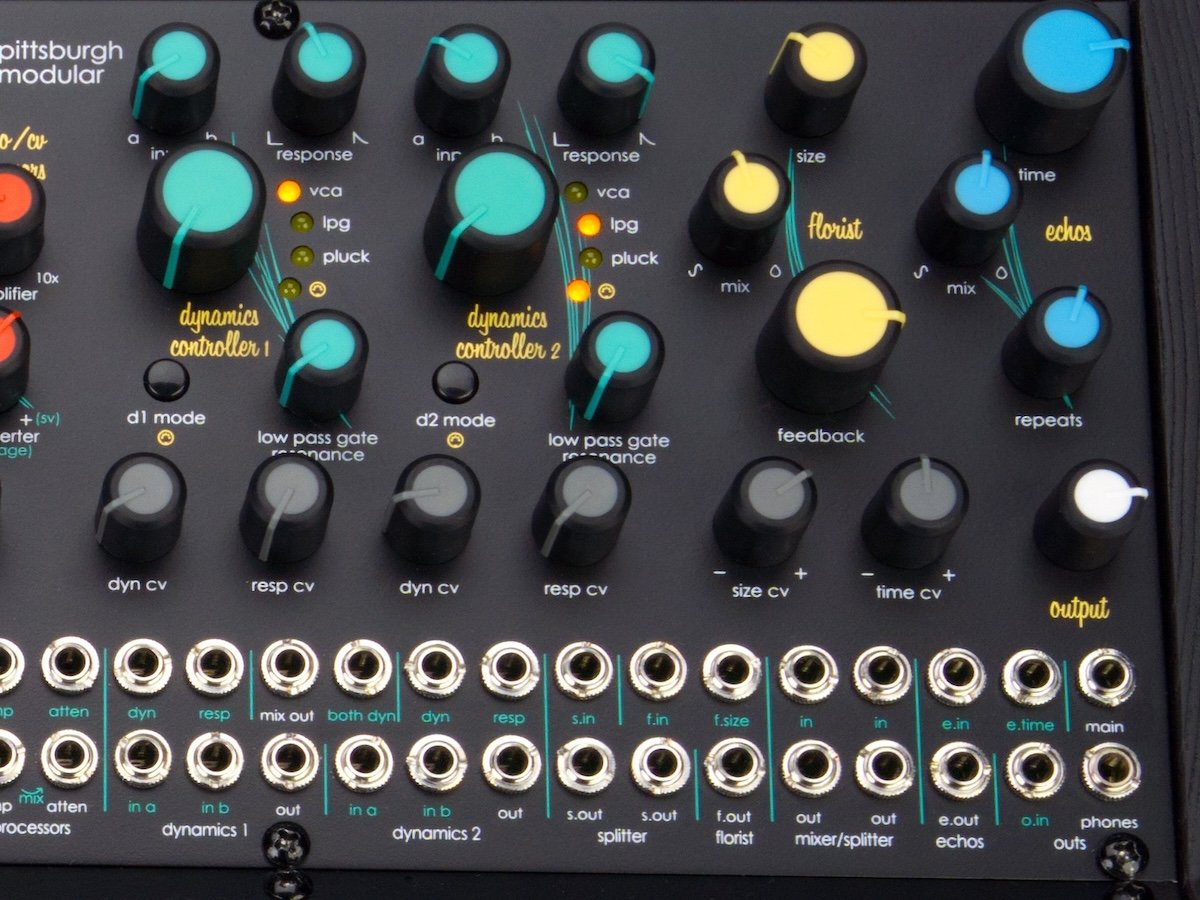
As we venture further to the right, we find two built-in effect processors: the Florist and Echos. These effects are similar to one another in concept: Florist is a sort of flanger/chorus/comb filter/simple reverberator with continuously variable size, mix, and feedback controls, along with a CV input and attenuverter for the size parameter. Likewise, the Echos section is an analog delay that goes from chorus-like time ranges all the way to quite long, albeit clock noise-laden repeats, with continuously variable control of effect mix, time, and repeats...again, with a CV input and attenuverter for the time control. These effects combined can give you everything from metallic resonances to swarmy, undulating tones to subdued, dark echos and organic, murky repeats. And remember, despite the fact that they are located on the right side of the panel, they don't need to be used at the end of your signal chain: they can be used at any point in your signal path.
The rightmost portion of the VL2 panel includes additional utilities, including a one-to-two signal multiple and a two-in, two-out mixer/signal splitter, as well as a headphone and line-level output section. With that, though, we conclude our quick (well, maybe not so quick) overview of the VL2 module. But...what about the Touch Controller?
Touch Controller 2: Sequenced, Gestural, and Algorithmic Control Combined
Touch Controller 2 is a significant development on the original Voltage Research Laboratory's touch controller. It couples control concepts from a variety of sources—and, indeed, it can function as both a control voltage-specific keyboard/sequencer or as a MIDI controller. Frankly, the Touch Controller 2 is deep and its possibilities vast, so I can't hope to cover absolutely everything that it does in this text. However, we can at least take a quick look.
The Touch Controller 2 has two primary "channels": the Red channel and the Yellow channel. These carry an identical set of features, and each can act either as a keyboard, sequencer, or as any number of peculiar hybrids of what one might think of as keyboard and sequencer-like behavior. What's more, each can function either in tandem with one another or completely independently of one another. That is to say, you could use the red channel, for instance, as a sequencer while the yellow channel functions purely as a keyboard (or vice versa). Each could act as a sequencer with a different number of steps; each could act as a sequencer that runs at different rates; one channel could be used in some ways to impact the behavior of the other; etc. Because it bears resemblance to something like Serge's TKB, it might be tempting to assume that its three rows of knobs are simply stored voltage accessed by acting individual touch plates—and while this is one possible use, it is only one use of many.
Both the red channel and yellow channel offer individual groups of inputs and outputs, including inputs for repeat, reset/1-shot, chance (a means of introducing uncertainty to the values sent out of the sequencer), and my personal favorite, scan—which allows for independent addressing of the red and yellow channels from external control voltages. So, for instance, you could use a function generator to "scan" the red or yellow channels—or you could use a random voltage to select random stages. Each channel also features six outputs: a key pressure CV output, pitch and CV outputs (which may be defined with the color-coded knobs, the keyboard, or sequence note entry from the keyboard), as well as three "CV Channel" outputs. The CV channel outputs include a dedicated CV output, as well as scaled envelope and gate outputs—all of which are defined by blue knobs (which affect each stage equally for both the red and yellow channels).
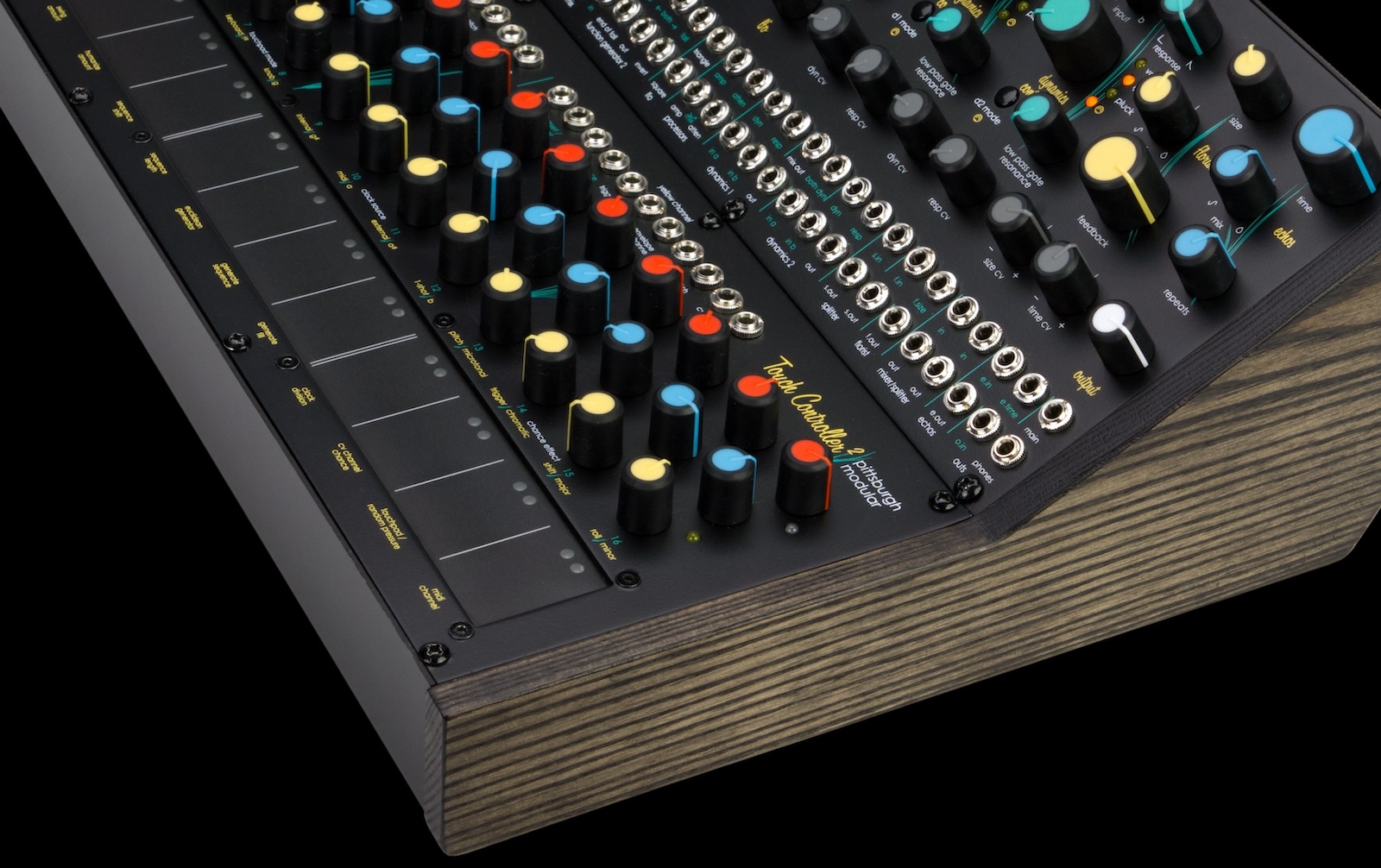
The sequencing functionality is complex—but that doesn't mean it's necessarily difficult to understand once you've had your hands on it. I won't go into the details about how you program the sequencer, but suffice it to say that it offers a huge range of musical possibilities, including Euclidean sequencing, ratcheting, swing, humanization, quantized and unquantized operation, chance-based sequence variation, a huge range of probabilistic or algorithmic methods of varying sequence data, and much more. It can be used to produce intricate, highly-controlled patterns (which, by the way, may be stored and recalled for later use)—but it can also be a tremendously inspiring source of exploratory inspiration. Set up a simple sequence and then modify from there, adding step conditions, chance, jumps, etc.—you'll find countless variations that resemble your original sequence, but all take the idea in new, unexpected directions. Oh, and did I mention that it has MIDI input and output? That's right—you can use it to interact with nearly any electronic music gear you like, modular or otherwise.
Despite the fact that the Touch Controller 2's possibilities are quite sophisticated, perhaps the best takeaway is this: it's quite simple to do simple things, and not difficult to learn to do complex things. It features many options for quantized outputs, and as such makes a great controller for tonal music; plus, it features a variety of options that will make it worthwhile for atonal experimentation, physical engagement with algorithmic processes, and much more.
Final Thoughts
Having gone quickly through all of Voltage Lab 2's surface-level possibilities, I'll remove myself from the weeds and offer some general thoughts. In the current landscape of electronic musical instrument development, it is a true rarity to see such a complete, unified instrument with such a clear and unique artistic vision from a relatively small and young company. Richard Nicol and Michael Johnsen—the two lead designers at Pittsburgh Modular—are no doubt clever and creative humans, and they've spent years gradually refining their craft and developing a lexicon of unique techniques. No doubt developing an instrument as deep and thorough as VL2 is a huge undertaking, and in some senses, a huge risk: it is relatively large, valuable, and presents its own idiosyncratic way of thinking about musical organization. In those senses, despite my general fondness of it, it seems fair to say that VL2 simply will not be "for" everyone.
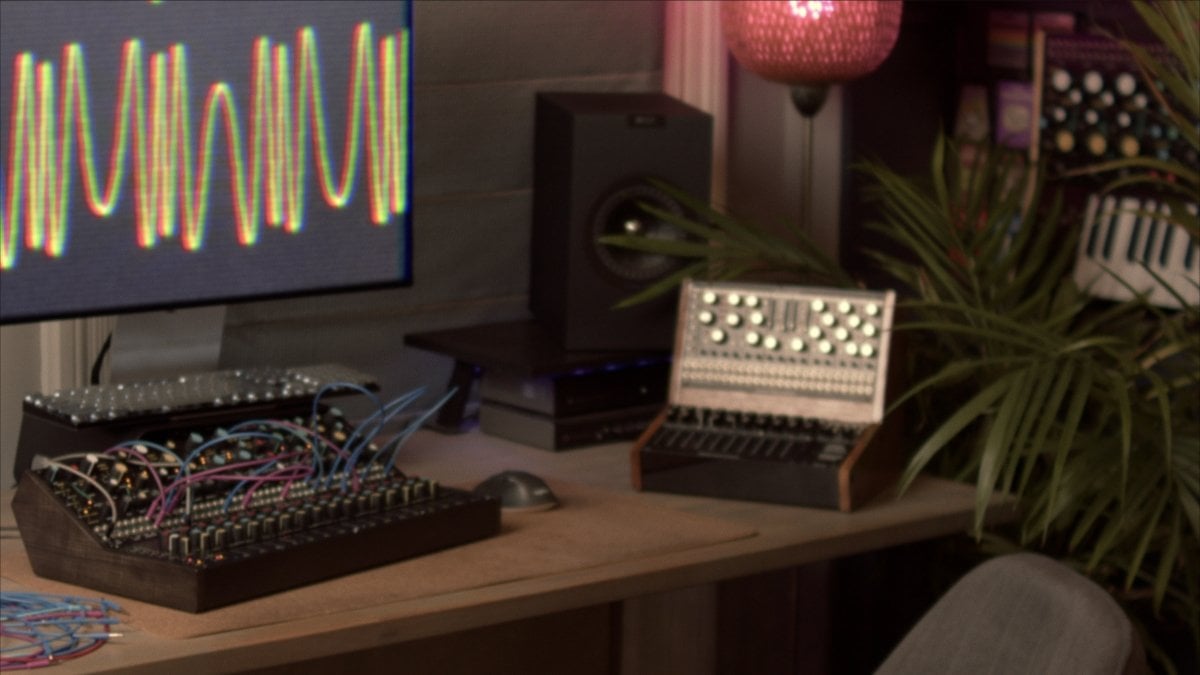
However, I for one am thrilled that Nicol, Johnsen, and their partners at Cre8audio saw past the potential risks and delivered what feels, to me, like a truly well-thought-out, no-compromises instrument. It's the sort of instrument that could easily become the center of someone's musical practice, and could lead them through years of constant new discoveries. Some of these discoveries will no doubt involve the appreciation new and novel sounds for their own sake—others will involve a gradually deepening sense of the vast creative possibilities presented by the interaction between oneself and a sufficiently rich and deep array of well-considered electronics. So, yes, you prospective owners of the VL2 will no doubt find new sounds...but I venture to guess that, if you want, you'll also find new ways of conceptualizing performance, composition, and the very purpose of music altogether.
I should also mention that, of course, VL2 is fully compatible with other modular and semi-modular equipment. This is, of course, a big plus, but I can't help but feel as if one of the things that is so special about VL2 is somewhat antithetical to a common public perception of the purpose of modular synthesizers: that it is, in itself, a relatively fixed yet bafflingly open-ended instrument architecture. If you want, a modular synthesizer can be about meticulously selecting from a wide range of tools in order to customize your own, personal, one-of-a-kind instrument. But, I feel like one of the VL2's exciting and refreshing logical propositions is that, perhaps, a fixed set of tools can be enough to inspire years of continual discovery. I'm sure that, with time, the seemingly "fixed" feature set of Voltage Lab 2 itself will fade away—boundaries between its internal modules and your initial perceptions of their "purpose" will blur—and you'll gradually realize that its many parts' potential uses are malleable and fluid, if not infinite.
If you want an instrument that you can truly build a relationship with, I wouldn't hesitate to recommend it.


